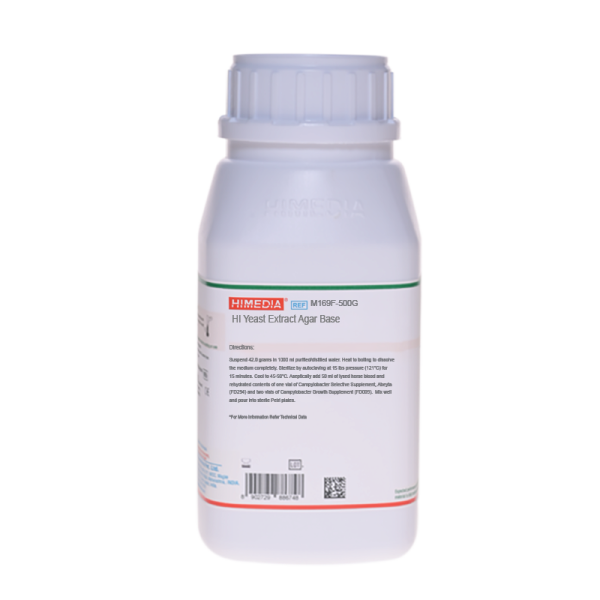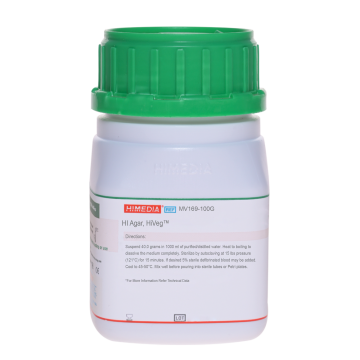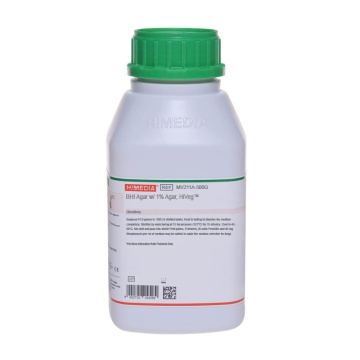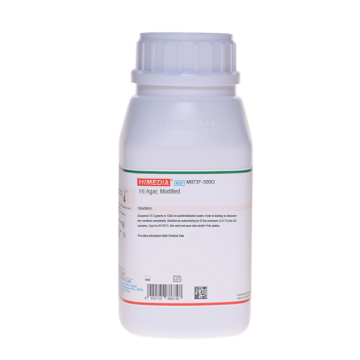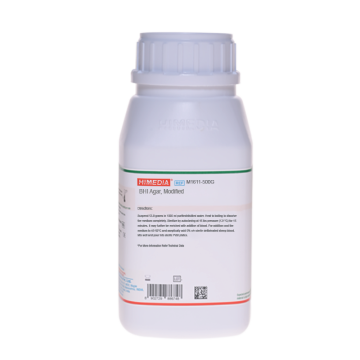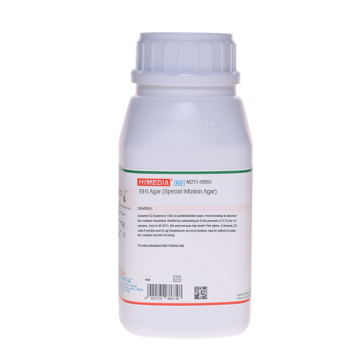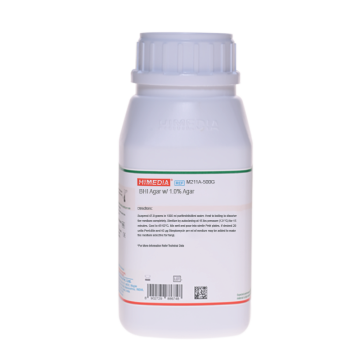 Your enquiry has been submitted
Your enquiry has been submitted
HI Yeast Extract Agar Base (Heart Infusion Yeast Extract Agar Base)
Intended Use
Heart Infusion Yeast Extract Agar Base is used for the isolation and cultivation of Campylobacter in accordance with FDA BAM 1998.
Composition**
| Ingredients | Gms / Litre |
|---|---|
| Meat infusion from # | 500.000 |
| Tryptose | 10.000 |
| Sodium Chloride | 5.000 |
| Agar | 15.000 |
| Yeast extract | 2.000 |
Final pH (at 25°C): 7.4±0.2
**Formula adjusted, standardized to suit performance parameters
# Equivalent to Beef heart infusion from
Directions
Suspend 42.00 grams in 475 ml of distilled water. Heat to boiling to dissolve the medium completely. Sterilize by autoclaving at 15 lbs pressure (121°C) for 15 minutes. Final pH, 7.4 ± 0.2. Add 25ml of sterile lysed horse blood (if desired) and 1 vial each of Campylobacter Growth Supplement (FD009) and Campylobacter Selective Supplement, Abeyta (FD294). Mix well and pour into sterile Petri plates. Do not dry in the hood with lids open.
Principle And Interpretation
Campylobacter are microaerophilic, very small, curved, thin, Gram-negative rods (1.5-5 µm), with corkscrew motility. It is considered to be one of the leading causes of enteric illness in the United States and other developed countries (1). The organism is reported to cause mild to severe diarrhea, with loose, watery stools often followed by bloody diarrhea. The infection together is called as campylobacteriosis. Campylobacter are carried in the intestinal tract of a wide variety of wild and domestic animals, especially birds and are frequent contaminants foods of animal origin (2).
Heart Infusion Yeast Extract Agar Base is used for selective isolation and differentiation of Campylobacter species in accordance with FDA BAM, 1998 (3). Initially blood was used in the isolation of Campylobacter. Fastidious organisms having exacting nutritional requirement could be cultivated on infusion media, as demonstrated by Huntoon (4). A liquid medium containing an infusion of meat was one of the first media used for the cultivation of bacteria (3). Heart Infusion Agar, containing meat infusion is used for the isolation and cultivation of a wide variety of fastidious organisms including Vibrio species (5, 3, 2). On supplementation of blood, Heart Infusion Agar can be used to study haemolytic reactions (6).
Tryptose and beef heart infusion provide nutritional requirements for the pathogenic bacteria. Sodium chloride maintains the osmotic equilibrium of the medium.
According to the BAM protocol, samples are pre enriched (if required) with suitable media under micro aerobic conditions for appropriate time at 37°C. These enriched cultures are further preceded for isolation, identification and confirmation. For isolation, appropriately diluted samples are inoculated into either Heart Infusion Yeast Extract Agar Base (M169F along with FD294 and/ or FD009) or Bloodfree Campylobacter Selectivity Agar Base, w/o yeast extract (M887F along with FD067). Plates are incubated at 37-42°C under anaerobic conditions away from light. Campylobacter colonies on agar appear as round to irregular with smooth edges. They can show thick translucent white growth to spreading, film-like transparent growth. These are further confirmed using microscopy and biochemical tests.
Quality Control
Appearance: Cream to yellow homogeneous free flowing powder
Gelling: Firm, comparable with 1.5% Agar gel
Colour and Clarity of prepared medium: Basal medium : Light yellow coloured, clear to slightly opalescent gel After addition of 5-7%w/v sterile defibrinated blood : Cherry red coloured, opaque gel forms in Petri plates
Reaction: Reaction of 4.0% w/v aqueous solution at 25°C. pH : 7.4±0.2
pH: 7.20-7.60
Cultural Response
Cultural characteristics observed with added 5-7% w/v sterile defibrinated blood, Campylobacter Growth Supplement (FD009) and Campylobacter Selective Supplement, Abeyta (FD294) after an incubation under reduced oxygen atmosphere at 35-37°C for 24-48 hours.
| Organism | Inoculum (CFU) | Growth | Recovery |
|---|---|---|---|
| Campylobacter jejuni ATCC 33291 | 50-100 | luxuriant | 50-70% |
| Campylobacter coli ATCC 33559 | 50-100 | luxuriant | 50-70% |
| Staphylococcus aureus ATCC 25923 | 50-100 | inhibited | 0% |
| Neisseria meningitidis ATCC 13090 | 50-100 | inhibited | 0% |
| Streptococcus pyogenes ATCC 19615 | 50-100 | inhibited | 0% |
| Escherichia coli ATCC 25922 | 50-100 | inhibited | 0% |
Storage and Shelf Life
Store below 30°C in tightly closed container and prepared medium at 2-8°C. Use before expiry period on the label.
Reference
- Tauxe, R.V., Hargrett-Bean, N., Patton, C.M. and Wachsmuth, I.K. 1988. Morbid. Mortal. Weekly Rep., 37: 1-13.
- Downes, F.P. and Ito, K. 2001. Methods For The Microbiological Examination of Foods. APHA, Food 4 ed. Washington, D.C.
- FDA, U.S. 1998. Bacteriological Analytical Manual. 8 ed. Gaithersburg, MD: AOAC International.
- Huntoon, F. 1918. J. Inf. Dis., 23.
- Atlas, R. M. 2004. A Handbook of Microbiological Media. 3 ed.: CRC Press.
- Murray, P. R., Baron, E. J., Jorgensen, J. H., Pfaller, M. A. and Yolken, R. H. 2003. Manual of Clinical Microbiology. 8 ed. Washington, D.C: ASM.
| Product Name | HI Yeast Extract Agar Base (Heart Infusion Yeast Extract Agar Base) |
|---|---|
| SKU | M169F |
| Product Type | Regular |
| Physical Form | Powder |
| Origin | Animal |
| Packaging type | HDPE |
| References | 1.Tauxe, R.V., Hargrett-Bean, N., Patton, C.M. and Wachsmuth, I.K. 198 2.Downes, F.P. and Ito, K. 2001. Methods For The Microbiological Examination of Foods. APHA, Food 4 ed. Washington, D.C. 3.FDA, U.S. 199 4.Huntoon, F. 191 5.Atlas, R. M. 200 4.A Handbook of Microbiological Media. 3 ed.: CRC Press. 6.Murray, P. R., Baron, E. J., Jorgensen, J. H., Pfaller, M. A. and Yolken, R. H. 200 3.Manual of Clinical Microbiology. 8ed. Washington, D.C: ASM. |
| Customized Product Available | No |



